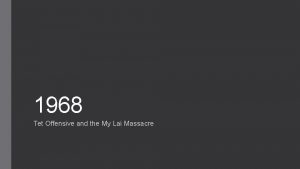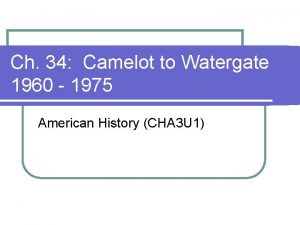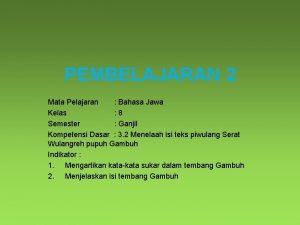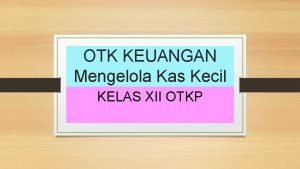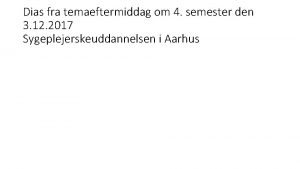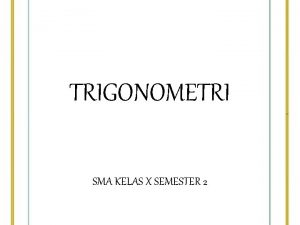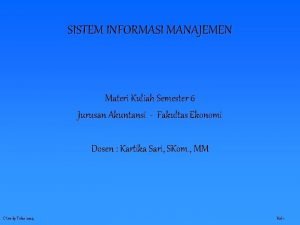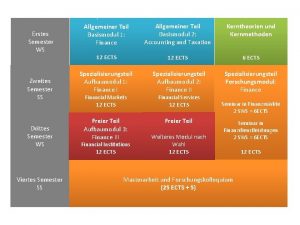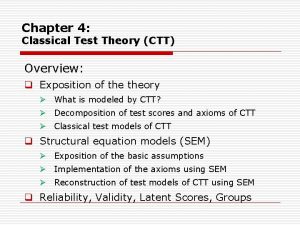The Saigon CTT Semester 1 CHAPTER 10 Wael






































































































- Slides: 102

The Saigon CTT Semester 1 CHAPTER 10 Wael Yousif

The Saigon CTT }Content • IP Address Classes. • Subnetting and Creating a Subnet. • Network Layer and Path Determination. • IP Address within the IP Header.

The Saigon CTT IP ADDRESS CLASSES

The Saigon CTT }IP network address • Network layer addresses are 32 bits long. • The are presented as four octets in dotted decimal format. • The IP address has two components: Network ID and Host ID.

The Saigon CTT }IP address format

The Saigon CTT }Binary and decimal conversion

The Saigon CTT }Why we need to know B-D conversion • Use of calculators is discouraged for one simple reason : No calculators are allowed on the CCNA exam.

The Saigon CTT }Fast conversion

The Saigon CTT }Exercise: DEC – BIN 203 11001011

The Saigon CTT }Exercise: BIN – DEC 10100010 162

The Saigon CTT }Network ID and host ID • Network ID : – Assigned by Internet Network Information Center. – Assigned by upper organization. – Identifies the network to which a devices is attached. • Host ID : – Assigned by a network administrator. – Identifies the specific device on that network.

The Saigon CTT }Bits on the IP address • Network Bits : – Identifies network ID – Identifies class of the IP address – All of host bits are 0 • Host Bits : – Identifies host ID – All of bits are 0: reserved for network address – All of bits are 1: reserved for broadcast address

The Saigon CTT }IP address classes • Different class addresses reserve different amounts of bits for the Network and Host portions of the address • Provide the flexibility required to support different size networks

The Saigon CTT }IP address classes: Class A

The Saigon CTT }IP address classes: Class A • The first bit of a Class A address is always 0. • The first 8 bits to identify the network part of the address. • Possible network address from 1. 0. 0. 0 to 127. 0. 0. 0. • The remaining three octets can be used for the host portion of the address. • Each class A network have up to 16, 777, 214 possible IP addresses.

The Saigon CTT }IP address classes: Class B

The Saigon CTT }IP address classes: Class B • The first 2 bits of a Class B address is always 10. • The first two octets to identify the network part of the address. • Possible network address from 128. 0. 0. 0 to 191. 255. 0. 0. • The remaining two octets can be used for the host portion of the address. • Class B network have up to 65. 534 possible IP addresses.

The Saigon CTT }IP address classes: Class C

The Saigon CTT }IP address classes: Class C • The first 3 bits of a Class C address is always 110. • The first three octets to identify the network part of the address. • Possible network address from 192. 0. 0. 0 to 223. 255. 0. • The remaining last octet can be used for the host portion of the address. • Class C network have up to 254 possible IP addresses.

The Saigon CTT }IP address classes: Summary • 1. 0. 0. 0 - 126. 0. 0. 0 : Class A. • 127. 0. 0. 0 : Loopback network. • 128. 0. 0. 0 - 191. 255. 0. 0 : Class B. • 192. 0. 0. 0 - 223. 255. 0 : Class C. • 224. 0. 0. 0 < 240. 0 : Class D, multicast. • >= 240. 0 : Class E, reserved.

The Saigon CTT }Network address • Network address provide a convenient way to refer to all of the addresses on a particular network or subnetwork. • Two hosts with differing network address require a device, typically a router, in order to communicate. • An IP address that ends with binary 0 s in all host bits is reserved for the network address.

The Saigon CTT }Broadcast address • Broadcast goes to every host with a particular network ID number. • An IP address that ends with binary 1 s in all host bits is reserved for the directed broadcast address. • An IP address with binary 1 s in all network bits and host bits is reserved for the local broadcast address.

The Saigon CTT }Local broadcast address STOP 255

The Saigon CTT }Directed broadcast address 192. 168. 20. 0 192. 168. 20. 255 Broadcast address

The Saigon CTT }Example: 172. 16. 200 • 172. 16. 200 is Class B address • Network portion: 172. 16 • Host portion: 20. 200 • Network address: 172. 16. 0. 0 • Broadcast address: 172. 16. 255

The Saigon CTT }Private addresses • According to RFC-1918. • Organizations make use of the private Internet address space for hosts that require IP connectivity within their enterprise network, but do not require external connections to the global Internet. • Class A: 10. 0. • Class B: 172. 16. 0. 0 - 172. 31. 0. 0. • Class C: 192. 168. 0. 0 - 192. 168. 255. 0.

The Saigon CTT }Preparation for LAB • 10. 4: IP address classes. • Lab companion: – 10. 4. 1.

The Saigon CTT }Lab 10. 4. 1: Step 1 • Review IP address classes and their characteristics.

The Saigon CTT }Lab 10. 4. 1: Step 2 1. What is the decimal and binary range of the first octet of class B IP addresses? – Decimal: 128 – 191 – Binary: 10000000 – 10111111 2. Which octet(s) represent the network portion of a class C IP address? – The first three octets 3. Which octet(s) represent the host portion of a class A IP address? – The last three octets

The Saigon CTT }Lab 10. 4. 1: Step 3 Host IP Address 218. 14. 55. 137 123. 1. 1. 15 150. 127. 221. 2 44 194. 125. 35. 19 9 175. 12. 239. 24 4 Addre Network Host ss Address Class s C 218. 14. 55 137 A 123 1. 1. 15 Broadcast Address 218. 14. 55. 255 123. 255 B 150. 127 221. 244 150. 127. 255 C 194. 125. 35 B 175. 12 199 194. 125. 35. 255 239. 244 175. 12. 255

The Saigon CTT }Lab 10. 4. 1: Step 4 – Valid address • 150. 100. 255 • 175. 100. 255. 18 • 195. 234. 253. 0 • 100. 0. 0. 23 • 188. 258. 221. 176 • 127. 34. 25. 189 • 224. 156. 217. 73

The Saigon CTT }Review • Classes of IP address and range of IP on each class. • Determine network portion and host portion in a IP address. • Understand about broadcast addresses. • Understand about valid host address. • Binary and Decimal conversion.

The Saigon CTT SUBNETTING AND CREATING A SUBNET

The Saigon CTT }Why we need to divide network? • Network administrators sometimes need to divide networks, especially large ones, into smaller networks: – Reduce the size of a broadcast domain. – Improve network security. – Implement the hierarchical managements. • So we need more network addresses for your network. But I want the outside networks see our network as a single network.

The Saigon CTT }Divide network by three

The Saigon CTT }Subnetting • Subnetworks are smaller divisions of network. • Subnet addresses include the Class A, Class B, or Class C network portion, plus a subnet field and a host field. • To create a subnet address, a network administrator borrows bits from the original host portion and designates them as the subnet field. • Subnet addresses are assigned locally, usually by a network administrator.

The Saigon CTT }What are the rules? – Number of subnets created = 2 ^ (Number of bits borrowed from the host section) – Number of subnets Available = 2 ^ (Number of bits borrowed from the host section) – 2 – Number of hosts created per subnet = 2 ^ (Number of bits remaining under the host section) – Number of hosts available per subnet = 2 ^ (Number of bits remaining from the host section) – 2

The Saigon CTT }How many bits can I borrow? • The minimum bits you can borrow is: 42 bits. • The maximum bits you can borrow is: 4 A: 22 bits ~ 222 - 2 = 4. 194. 302 subnets. 4 B: 14 bits ~ 214 - 2 = 16. 382 subnets. 4 C: 06 bits ~ 206 - 2 = 62 subnets.

The Saigon CTT }Why are we loosing 2? • Two addresses are reserved for the following: – Network Identifier. – Network Broadcast Address. • What is a network Identifier – The first IP address in a network, Known as the cable identifier, Represents the entire network, All host bits are turned off (0 s). • What is a Broadcast Address? – The last IP address in a network, used to communicate with all the hosts in the network, All host bits are turned On (1 s).

The Saigon CTT }Subnetting Challenges!! – Loosing IPs. – The outside world does not have any knowledge of our Subnetting plan. • How can we fix those two problems? – Loosing IPs. Router Configuration. – Subnetting Plan. – Subnetmask

The Saigon CTT What is a Subnetmask – Special 32 -bit number that, when combined (Logically Anded) with a device’s IP address, determines which network and subnetwork that particular device belongs to. For an external host to communicate with 166. 144. 63. 12, the router will need to interpret the Subnetmask Information.

The Saigon CTT }Subnet mask • “Extended Network Prefix”. • Determines which part of an IP address is the network field and which part is the host field. • 32 bits long. • Divided into four octets. • Network and Subnet portions all 1’s. • Host portions all 0’s.

The Saigon CTT }How is the Subnet Mask Is Written in Binary? – All bits under the network and subnetwork sections are turned on (1 s). • What is Default Subnetmask? – The subnet mask that will be used if you do not specify one in your TCP/IP configuration. • 255. 0. 0. 0 for Class A • 255. 0. 0 for Class B • 255. 0 for Class C

The Saigon CTT }Subnetting How would your subnet mask look if you borrow 3 host bits from class C network? ?

The Saigon CTT }Subnet mask: Example • 172. 16. 65. 100 / 255. 240. 0. • 10101100. 0001000001. 01100100. • 111111110000. • 10101100. 0001000001. 01100100. • Class B network: – 16 bits for network portion. – 4 bits for subnet portion. – 12 bits for host portion. • Subnet address: 172. 16. 64. 0.

The Saigon CTT }What is a Gateway? • Combination of software and hardware that enable two different network segments to exchange data. – The IP address of a router’s port through which a network is connected to the router. – Every device has a default gateway.

1. }Case 1 Suppose you are given the IP address 195. 5. 5. 0 and wish to connect Springfield and Bedrock to Southpark. Create an IP addressing scheme that will meet the following requirements: – A: Each subnet must support between 25 and 30 devices. – B: You must have enough subnets to address each network. i. What is the subnet mask for this network? ii. What is the broadcast address of the 3 rd subnet? iii. On the diagram, assign a subnet address to each network and give each router interface an appropriate IP address for that network.

The Saigon CTT }Case 2 • Given the IP address 199. 172 with a subnet mask of 255. 192. Answer the following: a. What is the subnet address of the network containing the given IP address? b. What is the broadcast address of the network containing the given IP address? c. How many bits were borrowed? d. How many subnets have been created? e. How many host address per subnet?

The Saigon CTT }Boolean algebra review • Boolean operators: –AND. –OR. –NOT.

The Saigon CTT }AND operator 1 AND 1 = 1 1 AND 0 = 0 0 AND 1 = 0 0 AND 0 = 0

The Saigon CTT }OR operator 1 OR 1 = 1 1 OR 0 = 1 0 OR 1 = 1 0 OR 0 = 0

The Saigon CTT }NOT operator NOT 1 = 0 NOT 0 = 1

The Saigon CTT }Boolean algebra examples 1010 AND 0110 = 0010 1010 OR 0110 = 1110

The Saigon CTT }Why we need to know Boolean ops? IP Subnet Network and AND = Address Mask Subnet address • Network layer performs the Boolean operations in order to find the network ID of a subnet • Example: – 172. 16. 65. 100 AND 255. 240. 0 – Network address: 172. 16. 64. 0

The Saigon CTT }Subnetting example • Given network 172. 16. 0. 0. • We need 8 usable subnets and up to 1000 hosts on each subnet.

The Saigon CTT }Calculating a subnet 1. Determine the class of network and default subnet mask. 2. Determine how many bits to borrow. Determine the subnet mask and the actual number of subnets and hosts. 3. Determine the ranges of host address for each subnet. Choose the subnets that you want to use.

The Saigon CTT }Calculating a subnet: STEP 1 • Determine the Class of network Class B • Determine the default subnet mask 255. 0. 0

The Saigon CTT }Calculating a subnet: STEP 2 • Number of subnets <= 2 n - 2 with n is number of bits that are borrowed. • Number of hosts <= 2 m - 2 with m is number of bits that are remained. • Determine how many bits to borrow from the host portion from requirement: – 8 subnets. – 1000 hosts on each subnet.

The Saigon CTT }Calculating a subnet: STEP 2 (Cont. ) • Choose n = 4: – Number of possible subnets is: 24 - 2 = 14 – Number of possible hosts on each subnet is: 2(16 -4) - 2 = 4094 • Other choice n = 5 , n = 6 ?

The Saigon CTT }Calculating a subnet: STEP 2 (Cont. ) The subnet mask: 255. 240. 0.

The Saigon CTT }Calculating a subnet: STEP 3 • Determine the subnets and the ranges of host address for each subnet. Including: Sub-network addresses Range of usable IP addresses Sub-network broadcast addresses

The Saigon CTT }Calculating a subnet: STEP 3 (Cont. ) • Determine the subnets from 4 borrowed bits from the host portion (last 2 bytes): • 1 st subnet: . 00000000 • 2 nd subnet: . 00010000 • 3 rd subnet: . 00100000 • … • 15 th subnet: . 11110000

The Saigon CTT }Calculating a subnet: STEP 3 (Cont. ) Sub-network address Possible host address Broadcast address Use ? 0 172. 16. 0. 1 – 172. 16. 15. 254 172. 16. 15. 25 5 N 1 172. 16. 0 172. 16. 1 – 172. 16. 31. 254 172. 16. 31. 25 5 Y 2 172. 16. 32. 0 172. 16. 32. 1 – 172. 16. 47. 254 172. 16. 47. 25 5 Y . . 13 172. 16. 208. 0 172. 16. 208. 1 – 172. 16. 223. 254 172. 16. 223. 2 55 Y No

The Saigon CTT }Calculating a subnet: STEP 3 (Cont. ) • Using subnets No. 1 to No. 8. • Assign IP addresses to hosts and interfaces on each network. IP address configuration.

The Saigon CTT }Addresses are loose by subnetting. • Network administrator must strike a balance between the number of subnets required, the hosts per subnet that is acceptable, and the resulting waste of addresses.

The Saigon CTT }Review • Why we need to divide a network. • What is the subnetting. • What is the subnet mask. • How to create subnet addresses.

The Saigon CTT }Teaching topology (10. 7. 6) p u o r g k or W

The Saigon CTT NETWORK LAYER AND PATH DETERMINATION

The Saigon CTT }A network layer. Why?

The Saigon CTT }Network layer • Segment network and control flow of traffic. • Move data through a set of networks. • Logical Addressing, use a hierarchical addressing scheme.

The Saigon CTT }Network segmentation. Why?

The Saigon CTT }Network segmentation • Control network traffics and reduce broadcast traffics. • Separate computer networks is managed by a single administration Autonomous systems.

The Saigon CTT }Communication among networks • Networks operate in much the same manner.

The Saigon CTT }Router • Routers connect separate networks. • Routers make best path decisions based on Layer 3 information. • Routers actually switch packets from incoming ports to appropriate outgoing ports.

The Saigon CTT }Data relaying

The Saigon CTT }Path determination • Path determination is the process that the router uses to choose the next hop in the path for the packet to travel to its destination based on the link bandwidth, hop, delay. . .

The Saigon CTT }Network layer addressing • Network address + Host address: Hierarchical Addressing Schemes.

The Saigon CTT }Flat Addressing Scheme 1 2 A 1 – A 1 2 – A 2 3 – A 3 3 B 1–A 2–A 3–A 4–B 5–B 6–B 4 5 6

The Saigon CTT }Hierarchical Addressing Scheme A 1 A 2 A 1 – A 1 2 – A 2 3 – A 3 B B 1 B 2 A – Local B – Switch to B B 3

The Saigon CTT }Hierarchical Addressing Scheme International Gateway Domestic Switch Local Switch 84 8 9321044

The Saigon CTT }Network address • The network address helps the router identify a path within the network cloud. • The router uses the network address to identify the destination network of a packet within an internetwork. • Network address is assigned by higherlevel administrator. Host address is assigned manually or automatically by manager of that network.

The Saigon CTT }Review • Why it’s necessary to have a network layer. • Why we need to segment networks. • What are the roles of router in network. • Compare flat and hierarchical addressing schemes.

The Saigon CTT IP ADDRESS WITHIN THE IP HEADER

The Saigon CTT }Network layer datagram • At the network layer, the data is encapsulated within packets (also known as datagrams). • Packet includes header - addressing and other control information - and actual data - whatever is passed down from the higher layers.

The Saigon CTT }IP header format

The Saigon CTT }IP header format: Version • 4 bits. • Indicates the version of IP currently used. – IPv 4 : 0100 – IPv 6 : 0110

The Saigon CTT }IP header format: Header length • 4 bits. • IP header length : Indicates the datagram header length in 32 bit words (4 bits), and thus points to the beginning of the data.

The Saigon CTT }IP header format: Service type • 8 bits. • Specifies the level of importance that has been assigned by a particular upper-layer protocol. • Precedence. • Reliability. • Speed.

The Saigon CTT }IP header format: Total length • 16 bits. • Specifies the length of the entire IP packet, including data and header, in bytes.

The Saigon CTT }IP header format: Identification • 16 bits. • Identification contains an integer that identifies the current datagram. • Assigned by the sender to aid in assembling the fragments of a datagram.

The Saigon CTT }IP header format: Flags • 3 bits. • The second bit specifying whether the packet can be fragmented. • The last bit specifying whether the packet is the last fragment in a series of fragmented packets.

The Saigon CTT }IP header format: Fragment offset • 13 bits. • The field that is used to help piece together datagram fragments. • The fragment offset is measured in units of 8 octets (64 bits). • The first fragment has offset zero.

The Saigon CTT }IP header format: Time to Live • 8 bits. • Time-to-Live maintains a counter that gradually decreases to zero, at which point the datagram is discarded, keeping the packets from looping endlessly.

The Saigon CTT }IP header format: Protocol • 8 bits. • Indicates which upper-layer protocol receives incoming packets after IP processing has been completed • 06 : TCP • 17 : UDP

The Saigon CTT }IP header format: Header checksum • 16 bits. • A checksum on the header only, helps ensure IP header integrity.

The Saigon CTT }IP header format: Addresses • 32 bits each. • Source IP Address • Destination IP Address

The Saigon CTT }IP header format: Options • Variable length. • Allows IP to support various options, such as security, route, error report. . .

The Saigon CTT }IP header format: Padding • The header padding is used to ensure that the internet header ends on a 32 bit boundary.

The Saigon CTT }Homework • www. ietf. org and RFC-760. • Groups presentations: – Internet Protocol Overview. – Packet fragment fields. – Type of services field. – Option field.

The Saigon CTT }Review • Detail of IP packet header.

The Saigon CTT }Preparation for LAB • Lab companion: – 10. 6. 6. – 10. 7. 5. – 10. 7. 7.

The Saigon CTT
 Saigon ctt
Saigon ctt Saigon ctt
Saigon ctt Saigonctt
Saigonctt Saigon ctt
Saigon ctt Saigonctt
Saigonctt Wael ouarda
Wael ouarda Wael is the teacher of n students
Wael is the teacher of n students The house of wael
The house of wael Saigon is gone poem
Saigon is gone poem Saigon palace
Saigon palace Eddie adams saigon execution
Eddie adams saigon execution Execution de saigon
Execution de saigon Saigon capital
Saigon capital Saigon 1975
Saigon 1975 All on 4 coût saigon
All on 4 coût saigon Saigon institute for techniques & technology
Saigon institute for techniques & technology Hát kết hợp bộ gõ cơ thể
Hát kết hợp bộ gõ cơ thể Frameset trong html5
Frameset trong html5 Bổ thể
Bổ thể Tỉ lệ cơ thể trẻ em
Tỉ lệ cơ thể trẻ em Chó sói
Chó sói Thang điểm glasgow
Thang điểm glasgow Chúa yêu trần thế
Chúa yêu trần thế Các môn thể thao bắt đầu bằng tiếng đua
Các môn thể thao bắt đầu bằng tiếng đua Thế nào là hệ số cao nhất
Thế nào là hệ số cao nhất Các châu lục và đại dương trên thế giới
Các châu lục và đại dương trên thế giới Cong thức tính động năng
Cong thức tính động năng Trời xanh đây là của chúng ta thể thơ
Trời xanh đây là của chúng ta thể thơ Mật thư anh em như thể tay chân
Mật thư anh em như thể tay chân 101012 bằng
101012 bằng Phản ứng thế ankan
Phản ứng thế ankan Các châu lục và đại dương trên thế giới
Các châu lục và đại dương trên thế giới Thể thơ truyền thống
Thể thơ truyền thống Quá trình desamine hóa có thể tạo ra
Quá trình desamine hóa có thể tạo ra Một số thể thơ truyền thống
Một số thể thơ truyền thống Cái miệng bé xinh thế chỉ nói điều hay thôi
Cái miệng bé xinh thế chỉ nói điều hay thôi Vẽ hình chiếu vuông góc của vật thể sau
Vẽ hình chiếu vuông góc của vật thể sau Nguyên nhân của sự mỏi cơ sinh 8
Nguyên nhân của sự mỏi cơ sinh 8 đặc điểm cơ thể của người tối cổ
đặc điểm cơ thể của người tối cổ V cc cc
V cc cc Vẽ hình chiếu đứng bằng cạnh của vật thể
Vẽ hình chiếu đứng bằng cạnh của vật thể Fecboak
Fecboak Thẻ vin
Thẻ vin đại từ thay thế
đại từ thay thế điện thế nghỉ
điện thế nghỉ Tư thế ngồi viết
Tư thế ngồi viết Diễn thế sinh thái là
Diễn thế sinh thái là Các loại đột biến cấu trúc nhiễm sắc thể
Các loại đột biến cấu trúc nhiễm sắc thể Bảng số nguyên tố
Bảng số nguyên tố Tư thế ngồi viết
Tư thế ngồi viết Lời thề hippocrates
Lời thề hippocrates Thiếu nhi thế giới liên hoan
Thiếu nhi thế giới liên hoan ưu thế lai là gì
ưu thế lai là gì Hổ sinh sản vào mùa nào
Hổ sinh sản vào mùa nào Khi nào hổ con có thể sống độc lập
Khi nào hổ con có thể sống độc lập Hệ hô hấp
Hệ hô hấp Từ ngữ thể hiện lòng nhân hậu
Từ ngữ thể hiện lòng nhân hậu Thế nào là mạng điện lắp đặt kiểu nổi
Thế nào là mạng điện lắp đặt kiểu nổi Jawabnya
Jawabnya Materi desain grafis kelas 10 semester 2
Materi desain grafis kelas 10 semester 2 Us history final exam study guide semester 1
Us history final exam study guide semester 1 Tugas tik kelas 9 semester 2
Tugas tik kelas 9 semester 2 Tugas tik kelas 8 semester 1
Tugas tik kelas 8 semester 1 Chemistry semester 2 review unit 12 thermochemistry
Chemistry semester 2 review unit 12 thermochemistry Kompetensi dasar kelas 3 semester 2
Kompetensi dasar kelas 3 semester 2 Keadaan alam vietnam
Keadaan alam vietnam Semester in san francisco
Semester in san francisco English 2 semester exam
English 2 semester exam Verbal irony def
Verbal irony def Biology second semester final exam answers
Biology second semester final exam answers Materi segitiga smp kelas 7 semester 2
Materi segitiga smp kelas 7 semester 2 Rangkuman materi ips kelas 7 semester 1
Rangkuman materi ips kelas 7 semester 1 Materi prakarya dan kewirausahaan kelas 10
Materi prakarya dan kewirausahaan kelas 10 Hasil tes matematika 14 orang siswa adalah 4 5
Hasil tes matematika 14 orang siswa adalah 4 5 Materi mice kelas 11 semester 2
Materi mice kelas 11 semester 2 Serat wulangreh kedadean saka …. pupuh
Serat wulangreh kedadean saka …. pupuh Contoh soal otk keuangan kelas 12
Contoh soal otk keuangan kelas 12 Otk keuangan kelas 11 semester 2
Otk keuangan kelas 11 semester 2 Materi matematika kelas 11 semester 2
Materi matematika kelas 11 semester 2 Rangkuman materi agama katolik kelas 12 semester 1
Rangkuman materi agama katolik kelas 12 semester 1 Ciri-ciri orang yang memelihara iman
Ciri-ciri orang yang memelihara iman Honors physics semester 2 review
Honors physics semester 2 review Sketchup angle
Sketchup angle World history semester 2 final review packet
World history semester 2 final review packet World history semester 1 final exam
World history semester 1 final exam Final exam study guide environmental science
Final exam study guide environmental science Earth science semester 2 final exam answers
Earth science semester 2 final exam answers Forudsætningskrav sygeplejerske 1 semester
Forudsætningskrav sygeplejerske 1 semester Clock hour to credit hour conversion
Clock hour to credit hour conversion Materi atletik kelas 6 sd
Materi atletik kelas 6 sd American history semester 2 final exam
American history semester 2 final exam Algebra 1 final review packet
Algebra 1 final review packet Academic calendar unsw
Academic calendar unsw Uf law externship
Uf law externship Tugas prakarya kelas 11
Tugas prakarya kelas 11 Trigonometri kelas 10 semester 2
Trigonometri kelas 10 semester 2 Kompetensi dasar fisika kelas 11 semester 1
Kompetensi dasar fisika kelas 11 semester 1 Spanish 1 final exam review packet answer key
Spanish 1 final exam review packet answer key Materi sistem informasi manajemen semester 5
Materi sistem informasi manajemen semester 5 Pengantar teknologi informasi semester 1
Pengantar teknologi informasi semester 1 Senior high school schedule of subjects
Senior high school schedule of subjects American literature semester 1 final
American literature semester 1 final For the remainder of the semester
For the remainder of the semester











